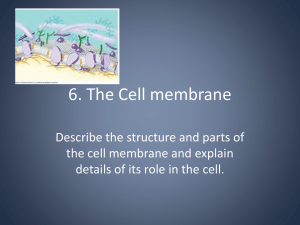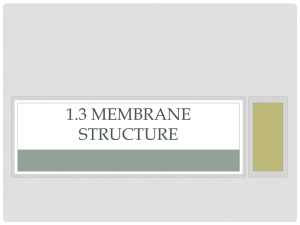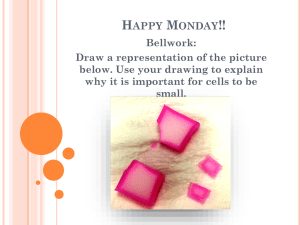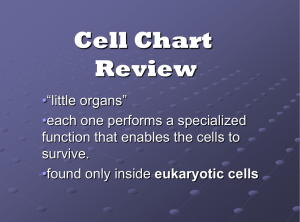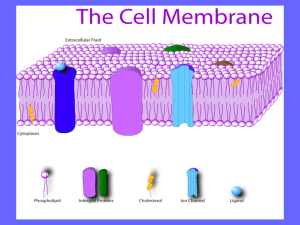Lec 16.
advertisement
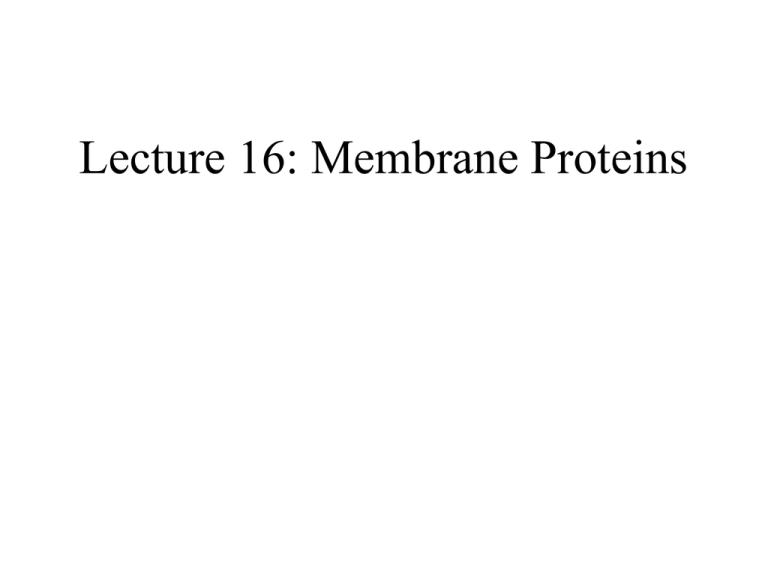
Lecture 16: Membrane Proteins Membrane proteins: 1) Overview: Types and Properties 2) Getting into the Membrane 3)What Membrane Proteins Do-examples 3) Working with Membrane Proteins Membrane Protein Overview -Membrane proteins are 25-35% of the genome. -Often important therapeutic targets: involved in signaling, transport, etc. -Can be anywhere from 25% (neurons) to 75% (mitochondria) by mass of the total membrane. -Under represented structurally Types of Membrane Proteins GPI-Anchored Alpha Helix Peripheral Beta-Barrel Fatty acid Chain Amphipathic Helix Beta-Barrel Proteins Alpha Helical Membrane Proteins -Can classify by number of transmembrane segments (multi vs single pass) and their topology in the membrane. -Different methods are used to predict if a polypeptide chain will cross a membrane. Hydropathy Plots for Alpha Helical Proteins: Classic Method For alpha-helical membrane proteins, you can use hydropathy plots to predict the probability that a segment will be within the membrane. These are generated by measuring, for each amino acid, its partition coefficient between water and a non-interacting, isotropic phase such as ethanol, and calculating from that partition coefficient a transfer free energy. Hydropathy Plots: New Method Von Heijne, Biochem Soc. Trans. 2011 Membrane Attachment by a Lipid Anchor -Common for proteins involved in signaling. -A fatty acid chain is attached via a amide or thioester linkage, and anchors the protein in the membrane. Membrane proteins: 1) Overview: Types and Properties 2) Getting into the Membrane 3)What Membrane Proteins Do-examples 3) Working with Membrane Proteins Getting into the Membrane: Destination Matters! Challenges of co-translational protein targeting Select Lots Translation the of right ribosomes ribosome is fast SRP and its receptor act as molecular matchmakers Signal peptides basic N-terminus ribosome 7-12 residue hydrophobic core SRP SRP ribosome SR SRP ribosome SR ribosome SRP SR The core protein targeting machinery is conserved SRP SRP14 SRP9 SRP Receptor SRP19 SRP72 SR SR SRP68 Eukaryotic (Human) SRP54 SRP-Type GTPases Ffh FtsY Bacterial (E. coli) Crystal Structure of the Prokaryotic SRP/SR QuickTime™ and a mpeg4 decompressor are needed to see this picture. Ataide et al., Science 2011 SRP and SR are GTPases SR GMPPCP D139 a.w. Mg Mg D135 a.w. SRP GMPPCP Egea et. al.,Nature, 2004 and Focia et al., Science, 2004 GTP hydrolysis and the SRP targeting cycle ribosome SRP GTP SRP GDP ribosome SR GTP SRP SR GTPGTP ribosome SR GDP Co-translational protein targeting: Structure of RNC-translocon complex Frauenfeld et al., PNAS 2011 Structure of the Translocon Top view Side view van den Berg et al., Nature 2004 Translocon features: the plug and the lateral gate van den Berg et al., Nature 2004 Translocon activity! van den Berg et al., Nature 2004 Getting into the ER: Single Nterminal TM Segment Getting into the ER: Positive Inside Rule The Problem with Tail Anchored Proteins: Post Translational Targeting: Tail Anchored Proteins Hedge and Keenan, 2011 The GET Complex Targets TailAnchored Proteins Hedge and Keenan, 2011 Post-translational Protein Targeting in Prokaryotes Very hydrophobic and basic signal peptides go through SRP-dependent pathway. Others go through SecB Folded proteins go through the Tat pathway Cross et al., 2009 Model for SecA-mediated Protein Translocation How does SecA use the energy of ATP hydrolysis to push a polypeptide through the translocon? Structural studies suggest that a “two helix finger” with a tyrosine paddle pushes the polypeptide into the translocon. It’s actions are coordinated with that of the peptide binding clamp, which has different conformational states during ATP hydrolysis. Zimmer et al., Nature 2008 Twin Arginine Transporter: Transports Folded Proteins Signal sequence contains twin arginines Palmer and Berks Nature Reviews Microbiology 2012 Chloroplasts and Mitochondria Have Their Own Genome but Most Proteins are Made in the Cytosol and Imported. Trafficking to Mitochondrial Membranes Membrane proteins: 1) Overview: Types and Properties 2) Getting into the Membrane 3)What Membrane Proteins Do-examples 4) Working with Membrane Proteins Functions of Membrane Proteins: Signaling Transporters Enzymes Anchors Signaling: IRE1 and the Unfolded Protein Response Signaling: IRE1 and the Unfolded Protein Response Kawaguchi and NG, Science 30 September 2011 Transporters: Aquaporins Gonen et al., Nature 2005 Enzymes: FtsH, a Membrane Bound Protease Krzywda et al., Structure 2002 and Bieniossek et al., PNAS 2009 Membrane proteins: 1) Overview: Types and Properties 2) Getting into the Membrane 3)What Membrane Proteins Do-examples 4) Working with Membrane Proteins Working with Membrane Proteins: Pick Detergents Wisely Proteoliposomes Not Many Membrane Protein Crystal Structures Solved Hegde RS, Keenan RJ Nature Reviews cell Biology 2011. Lipidic Cubic Phase for Membrane Proteins Ehud M. Landau and Jürg P. Rosenbusch, PNAS 1996, and Nollert et al., FEBS Letters 2001 Electron Crystallography: An Example (Wza) Neg. Stain Diffraction Pattern 2-D crystals Class averages of single particles Nesper et al.,JBC 2003 Electron Crystallography: Aquaporin Gonen et al., Nature 2005 Electron Crystallography: Solved Structures Wisedchaisri et al., Nature 2005


